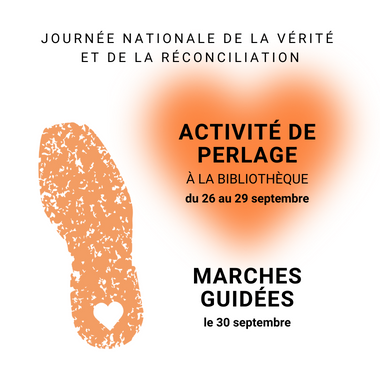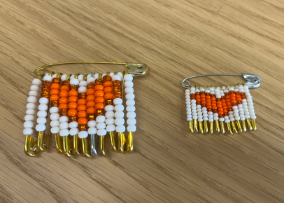Ce post a été écrit en consultation avec la bibliothécaire Allison Sivak et traduit par Linda Gisenya.
Le vendredi 30 septembre marque la Journée nationale de la vérité et de la réconciliation. À cette occasion, les cours seront annulés et les services du campus, y compris la bibliothèque, seront fermés pour permettre aux étudiants et au personnel de se pencher sur les conséquences des pensionnats canadiens. Pour soutenir cette réflexion, la bibliothèque invite les étudiants et le personnel à participer aux activités suivantes.

Activité de perlage
Les broches en perles portées sur les chandails orange sont des symboles qui marquent l’impact des pensionnats sur les peuples autochtones du Canada. La Journée nationale de la vérité et la réconciliation est également connue sous le nom de Journée du chandail orange. Le symbole du chandail orange provient de l’histoire de Phyllis (Jack) Webstad, une femme Secwépemc (Shuswap) du Nord de la Première Nation Stswecem’c Xgat’tem (bande indienne de Canoe Creek). Phyllis a été forcée à entrer dans un pensionnat, comme l’ont été plus de 150 000 enfants autochtones pendant plus d’un siècle.
“À six ans, Phyllis est allée pour la première fois à son école au pensionnat de la mission St. Joseph. Elle portait un chandail orange tout neuf, cadeau de sa grand-mère (Kyé7e [QUE-A-AH]). On le lui a enlevé et on ne le lui a jamais rendu”.
(Orange Shirt Society.n.d.)
Au cours de la semaine précédant la Journée nationale de la vérité et de la réconciliation, la bibliothèque vous invite à créer une broche en perles pour mettre sur votre chandail orange.Vous pourrez ainsi passer du temps dans la bibliothèque à créer votre broche et à réfléchir aux conséquences des pensionnats canadiens sur les peuples autochtones. Le fait de se souvenir est un moyen de s’assurer que nous agissons pour mettre fin à la colonisation, et que les Canadiens qui ne sont pas autochtones ne commettent plus jamais de génocide culturel sur les peuples autochtones.

Pendant que vous vous asseyez pour faire votre broche, vous pouvez discuter avec d’autres personnes, lire les ressources que nous avons sur les pensionnats, ou réfléchir tranquillement aux moyens de répondre aux 94 appels à l’action de la Commission de vérité et de réconciliation du Canada.
Le modèle de broche ont été créés par Felice Gladue, qui nous a permis de les partager. Vous trouverez le matériel pour l’activité de perlage aux bibliothèques Rutherford, Cameron, Scott, Campus Saint-Jean et Augustana du 26 au 29 septembre.
Marches guidées
Veuillez nous rejoindre pour participer à un enseignement et un apprentissage ancré dans le territoire le 30 septembre 2022. Deux marches sont prévues ce jour-là, chacune considérant l’histoire de ces terres et de leurs habitants sous différents points de vue.
Guidés par des gardiens du savoir, des historiens locaux et des membres de la communauté, nous écouterons un ensemble d’histoires uniques mais également liées les unes aux autres.
Nous réfléchirons à la manière dont les histoires permettent de se souvenir ou d’effacer les personnes, les communautés et les espaces sacrés.
Nous examinerons le passé, le présent et les meilleures façons d’avancer ensemble.
MARCHE DU MATIN :
De 9h à 11h, le 30 septembre 2022
ᐄᓃᐤ (ÎNÎW) River Lot 11∞ Indigenous Art Park (10380 Queen Elizabeth Park Road) to the Rossdale Burial Ground (10419 95 Avenue NW)
MARCHE DE L’APRÈS-MIDI:
De 13h à 15h, le 30 septembre, 2022
MacEwan Treaty 6 Marker outside kihêw waciston, Allard Hall (11110 104 Ave NW) to the Twin Graveyards: Edmonton Municipal (11820 107 Avenue NW) and Saint Joachim (10500 117 Street NW)
Inscrivez-vous pour assister à une ou aux deux marches (matin et après-midi)
Références:
Orange Shirt Society. “Orange Shirt Society Resources” n.d. https://www.orangeshirtday.org/orange-shirt-society-resources.html
